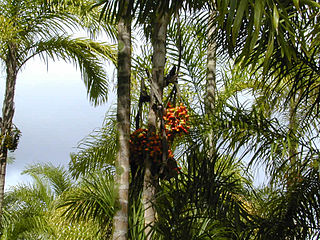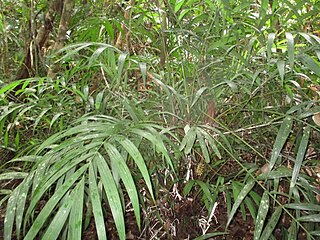
Bactris is a genus of spiny palms which are native to Mexico, South and Central America and the Caribbean. Most species are small trees about 2 m tall, but some are large trees while others are shrubs with subterranean stems. They have simple or pinnately compound leaves and yellow, orange, red or purple-black fruit. The genus is most closely related to several other spiny palms—Acrocomia, Aiphanes, Astrocaryum and Desmoncus. The fruit of several species is edible, most notably B. gasipaes, while others are used medicinally or for construction.

Aiphanes is a genus of spiny palms which is native to tropical regions of South and Central America and the Caribbean. There are about 26 species in the genus, ranging in size from understorey shrubs with subterranean stems to subcanopy trees as tall as 20 metres (66 ft). Most have pinnately compound leaves ; one species has entire leaves. Stems, leaves and sometimes even the fruit are covered with spines. Plants flower repeatedly over the course of their lifespan and have separate male and female flowers, although these are borne together on the same inflorescence. Although records of pollinators are limited, most species appear to be pollinated by insects. The fruit are eaten by several birds and mammals, including at least two species of amazon parrots.

Syagrus is a genus of Arecaceae (palms), native to South America, with one species endemic to the Lesser Antilles. The genus is closely related to the Cocos, or coconut genus, and many Syagrus species produce edible seeds similar to the coconut.

Roystonea is a genus of eleven species of monoecious palms, native to the Caribbean Islands, and the adjacent coasts of the United States (Florida), Central America and northern South America. Commonly known as the royal palms, the genus was named after Roy Stone, a U.S. Army engineer. It contains some of the most recognizable and commonly cultivated palms in tropical and subtropical regions.

Aiphanes horrida is a palm native to northern South America and Trinidad and Tobago. Aiphanes horrida is a solitary, spiny tree. In the wild it grows 3–10 metres tall tall with a stem diameter of 6–10 centimetres ; cultivated trees may be as much as 15 m (49') tall with a 15 cm (6") diameter. The epicarp and mesocarp of the fruit are rich in carotene and are eaten in Colombia, while the seeds are used to make candles. In parts of the Colombian Llanos endocarps are used to play games.

Aiphanes minima is a spiny palm tree which is native to the insular Caribbean from Hispaniola to Grenada, and widely cultivated elsewhere. Usually 5–8 metres (16–26 ft) tall, it sometimes grows as an understorey tree and only 2 m (6.6 ft) in height.
Bactris campestris is a small spiny palm which grows in multi-stemmed clumps in savannas and low forests in northern South America from Colombia to the Guianas, Trinidad and Tobago, and northern Brazil.

Desmoncus is a genus of mostly climbing, spiny palms native to the Neotropics. The genus extends from Mexico in the north to Brazil and Bolivia in the south, with two species present in the southeastern Caribbean.

Attalea crassispatha is a palm which is endemic to southwest Haiti. The most geographically isolated member of the genus, it is considered a critically endangered species and has been called one of the rarest palms in the Americas.
Aiphanes chiribogensis is a species of palm which is endemic to western Ecuador. Its natural habitats are subtropical or tropical moist lowland forests and subtropical or tropical moist montane forests. It is threatened by habitat loss.

Aiphanes duquei is a species of palm that is endemic to Colombia. Known from only a small area in the Cordillera Occidental, it is threatened by habitat loss and forest management practices.
Aiphanes leiostachys is a species of palm that is endemic to Colombia. Known from only a few forest fragments in the Cordillera Central, it is threatened by habitat loss and forest management practices.
Aiphanes lindeniana is a species of palm that is endemic to Colombia. Although widespread in the Cordillera Occidental and Cordillera Central, it is threatened by habitat loss and forest management practices.

Korthalsia is a clustering genus of flowering plant in the palm family spread throughout Southeast Asia. It is a highly specialized rattan with some species known to have an intimate relationship with ants, hence the common name ant rattan. High-climbing and armed with spines, the genus is named for the Dutch botanist P. W. Korthals who first collected them from Indonesia.

Lytocaryum is a monoecious genus of flowering plant in the palm family endemic to the Atlantic coast of Brazil, where 4 species are known. Palms once classified as Microcoelum are herein included; the genus is closely related to Syagrus, from which it is differentiated only by abundant tomentum, strongly versatile anthers, and slight epicarp, mesocarp, and endocarp differences. The name is Greek for "loose" and "nut".

Mauritiella is a dioecious genus of flowering plant in the palm family found in South America where it is commonly called buriti. It is named after the similar and closely related genus Mauritia.
Plectocomiopsis is a dioecious genus of flowering plant in the palm family found in Indochina, Malaysia, Borneo and Sumatra. Hapaxanthic and armed with spines, they are a climbing rattan, closely related to the Myrialepis palms. The name is Greek for "similar to Plectocomia", another close relative.
Aiphanes bicornis is a species of small, pinnately leaved palm which is endemic to Ecuador. First described in 2004 and known from only two locations, the species name refers to the deeply notched tips of its leaflets, which resemble a pair of horns.
Aiphanes eggersii, known locally as corozo, is a species of spiney, pinnately leaved palm which is native to the coastal plain of Ecuador and adjacent dry forests of Peru.

Pinanga cattienensis is a species of small palm in the family Arecaceae. It is endemic to Vietnam, having been found in Cat Tien National Park in Đồng Nai Province, growing in seasonally-flooded tropical forest at low elevations.











